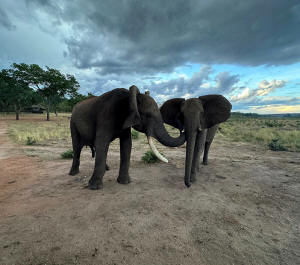For elephants, like people, greetings are a complicated affair
 Send a link to a friend
Send a link to a friend
 [May 14, 2024]
By Will Dunham [May 14, 2024]
By Will Dunham
(Reuters) - People greet each other in a variety of ways. They might say
"hello," "guten tag," "hola," "konnichiwa" or "g'day." They might shake
hands, bump fists, make a fist-and-palm gesture or press their hands
together with a gentle head bow. They might kiss on the cheek or hand.
And they might give a nice big hug.
For elephants, greetings appear to be a similarly complex affair. A
study based on observations of African savannah elephants in the Jafuta
Reserve in Zimbabwe provides new insight into the visual, acoustic and
tactile gestures they employ in greetings, including how greetings
differ depending on factors such as their sex and whether they are
looking at each other.
"Elephants live in a so-called 'fission-fusion' society, where they
often separate and reunite, meeting after hours, days or months apart,"
said cognitive and behavioral biologist Vesta Eleuteri of the University
of Vienna in Austria, lead author of the study published this month in
the journal Communications Biology.
Elephants, Earth's largest land animals, are highly intelligent, with
keen memory and problem-solving skills and sophisticated communication.
Female elephants of different family groups might have strong social
bonds with each other, forming "bond groups." Previous studies in the
wild reported that when these groups meet, the elephants engage in
elaborate greeting ceremonies to advertise and strengthen their social
bond, Eleuteri said.
Male elephants have weaker social bonds, and their greetings may
function more to ease possible "risky reunions" - a hostile interaction.
They greet mainly by smelling each other, reaching with their trunks,
Eleuteri added.

The study detailed around 20 gesture types displayed during greetings,
showing that elephants combine these in specific ways with call types
such as rumbles, roars and trumpets. It also revealed how smell plays an
important role in greetings, often involving urination, defecation and
secretions from a unique elephant gland.
Elephants may greet by making gestures intended to be seen, like
spreading the ears or showing their rump, or with gestures producing
distinct sounds like flapping the ears forward, or with tactile gestures
involving touching the other elephant.
"We found that they select these visual, acoustic and tactile gestures
by taking into account whether their greeting partner was looking at
them or not, suggesting they're aware of others' visual perspectives.
They preferred using visual gestures when their partner was looking at
them, while tactile ones when they were not," Eleuteri said.
[to top of second column]
|

The male savannah elephant Doma and the female savannah elephant
Kariba engage in greeting behavior at Jafuta Reserve in Zimbabwe in
this undated handout picture. Vesta Eleuteri/Handout via REUTERS

Greeting behavior has been studied in various animals.
"Many other species greet, including different primates, hyenas and
dogs," Eleuteri said. "Animal greetings help mediate social
interactions by, for example, reducing tension and avoiding
conflict, by reaffirming existing social bonds, and by establishing
dominance status using different behaviors."
The new research built on previous studies of elephant greeting
behavior. The nine observed elephants - four females and five males
- were "semi-captive," freely roaming their natural environment
during daytime and kept in stables at night.
Greetings used by the female elephants closely matched the behavior
of wild elephants. The greeting behavior of the male elephants
appeared to differ from their wild counterparts. Wild male elephants
tend to be solitary, forming loose associations with other
elephants.
The temporal gland, midway between the eye and the ear, secretes a
substance called temporin containing chemical information about an
elephant's identity or emotional and sexual state. Elephants often
use their trunks to check out the temporal glands of others.
"The urine and feces of elephants also contain chemical information
important for elephants, like the identity of the individual, their
reproductive state or even their emotional state," Eleuteri said.
"Elephants might defecate or urinate during greetings to release
this important information. Another option is that they do this due
to the excitement of seeing each other. But the fact that the
elephants often moved their tails to the side or waggled their tails
when urinating and defecating suggests they may be inviting the
recipients to smell them. Maybe they don't need to tell each other
how they're doing, as they can smell it," Eleuteri added.
(Reporting by Will Dunham in Washington, Editing by Rosalba O'Brien)
[© 2024 Thomson Reuters. All rights reserved.]This material
may not be published, broadcast, rewritten or redistributed.
Thompson Reuters is solely responsible for this content. |